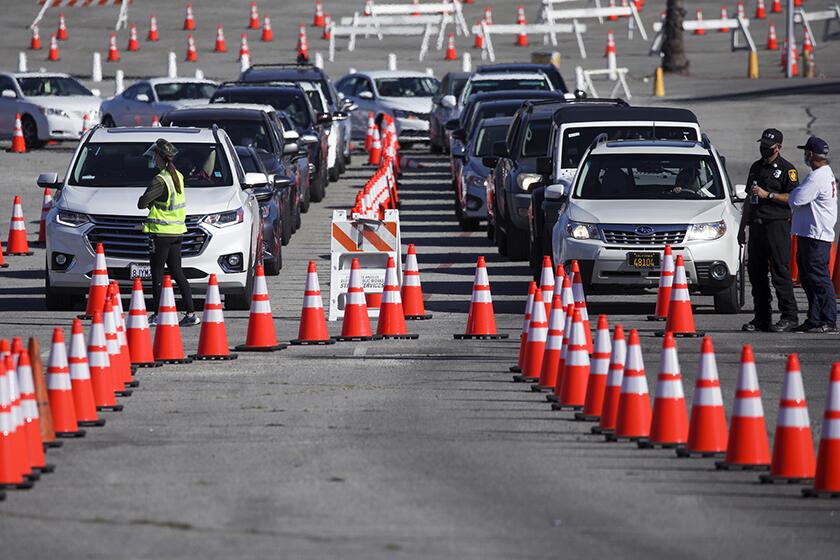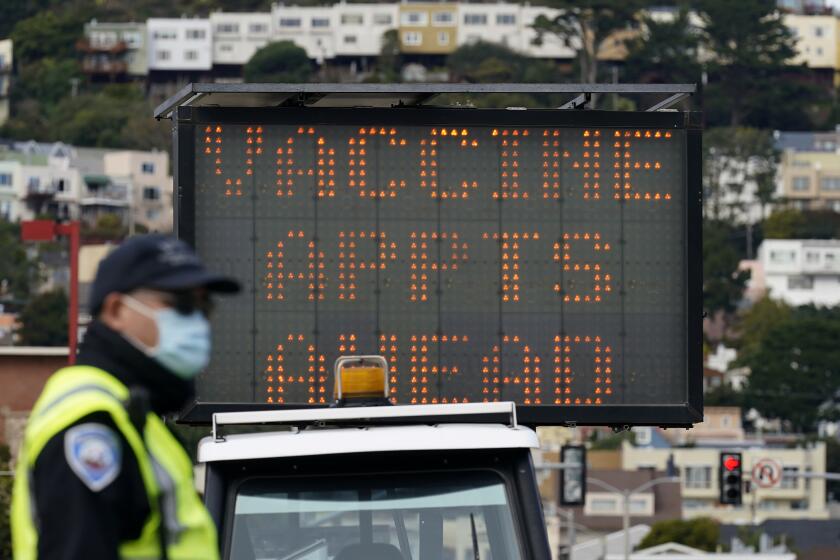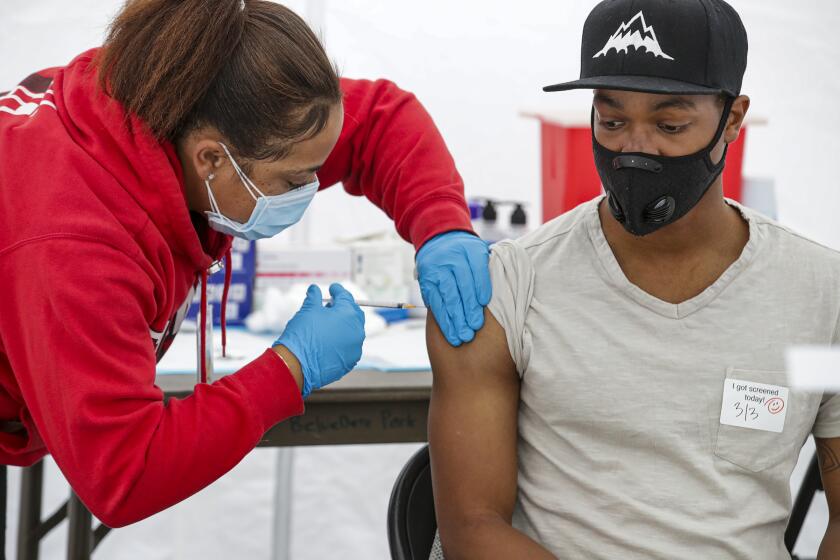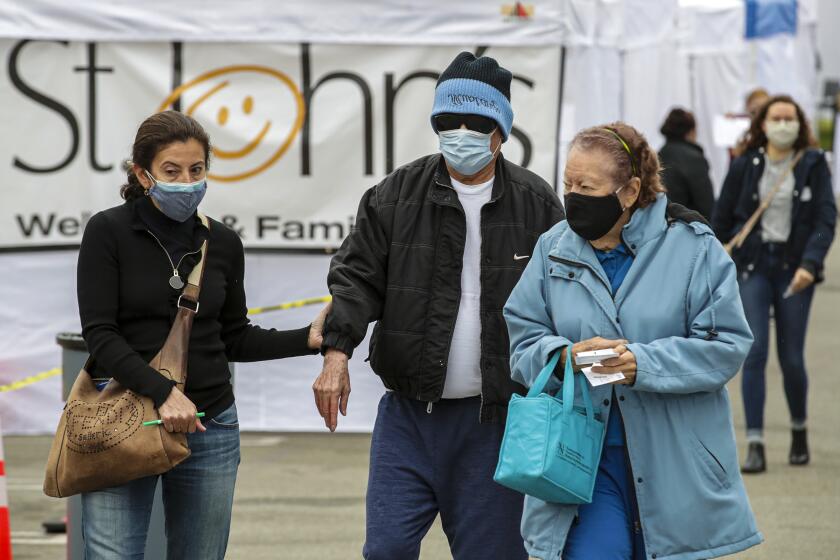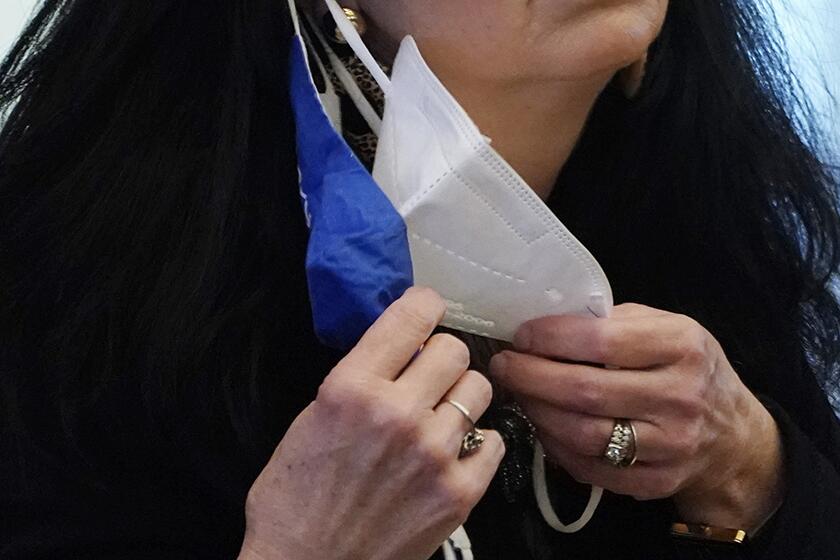California thinks it can stop COVID by flooding poor areas with vaccine. Will it work?
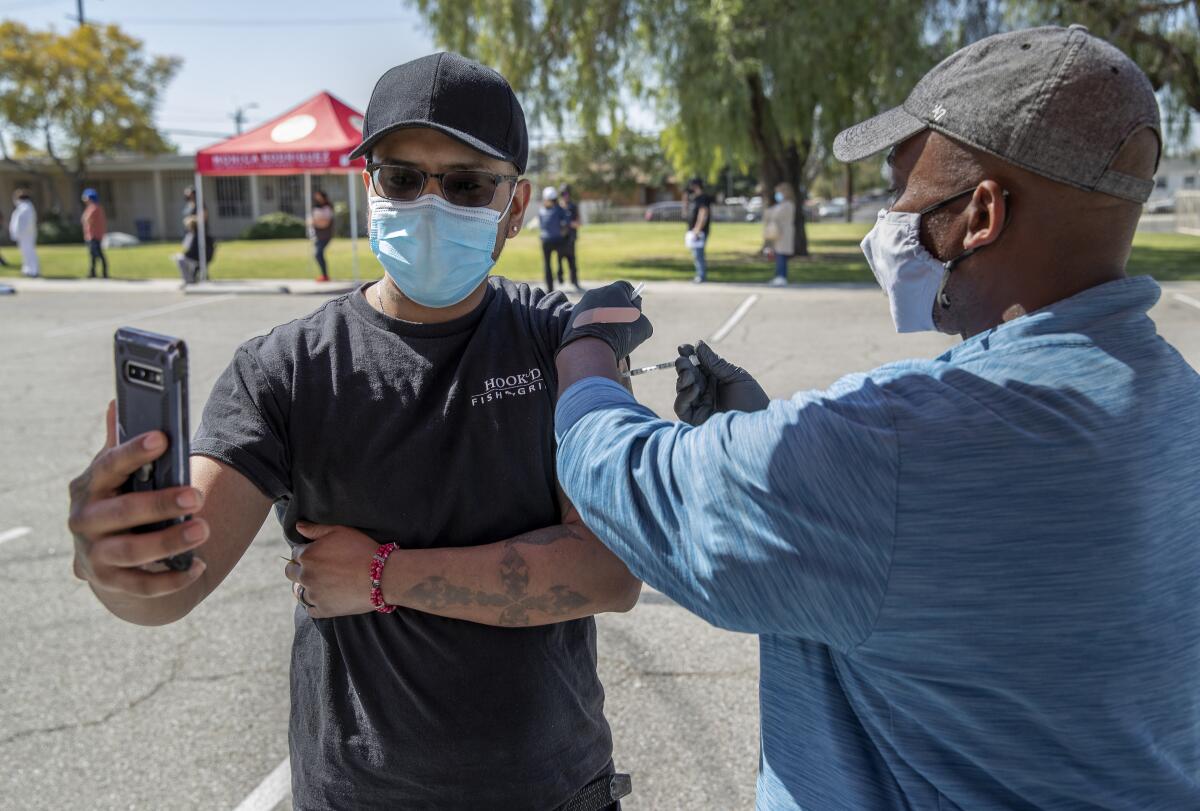
- Share via
Months into a vaccine rollout that has been stymied by shortages and marred by persistent inequities, California is now going all in on a new strategy: flooding those communities hardest hit by COVID-19 with doses.
Officials say they hope the radical shift unveiled this week will not only slow the spread of the disease and tackle glaring inequities in who is receiving vaccines, but also speed up reopening of the economy by inoculating essential workers who are putting themselves at greater risk.
Under the new approach, the state will now provide 40% of its available supplies to underserved areas, such as in South L.A., the Eastside, Santa Ana and the heavily Latino communities along the Interstate 10 corridor between Pomona and San Bernardino — places that have experienced a disproportionate share of the pandemic’s pain, yet still lag behind more affluent neighborhoods when it comes to getting vaccines.
The dramatic change in California’s allocation strategy reflects the growing view from state officials that they must more equitably balance vaccinating those most in danger of dying of COVID-19 and those who have the greatest risk of contracting and spreading the disease because of where they work and live.
Researchers are increasingly finding that the vaccines can play a pivotal role in tamping down transmission of the coronavirus, and that’s a key reason to focus on hard-hit communities, Gov. Gavin Newsom said Thursday.
State officials said the move is designed to both slow the spread of coronavirus and speed up the reopening of the economy.
“We can’t safely reopen our economy until we get this disease behind us,” he said. “We can’t honestly do that unless we address those communities that are disproportionately vulnerable to this pandemic and its deadly impacts.”
Deciding who should get access to the COVID-19 vaccine has long been an ethical minefield, as the demand and need for doses has continually outstripped supply.
But some experts say giving priority to residents in higher-risk communities — many of whom live in crowded or communal settings and have jobs requiring them to be on-site — makes sense right now.
Though older Californians were among the first groups to become eligible to receive vaccines, people under 65 actually make up the majority of people hospitalized with COVID-19 nationwide, said UC San Francisco epidemiologist Dr. Kirsten Bibbins-Domingo.
When analyzing COVID-19 deaths among people who don’t live in nursing homes, about one-third are people under 65, many of them essential workers, she said.
“The goal has to be to go where the virus is,” she said, and she called it “common sense” to take vaccines to the places where transmission is highest.
“It turns out it’s also compatible with equity, and it might help you to achieve both goals together,” Bibbins-Domingo said. “We could probably achieve most of the goals we’re talking about if we actually just went to the ZIP codes that had the most cases.”
Why is California putting an insurance company in charge of vaccinating millions of uninsured people anyway? Will this really help achieve equity?
California’s move is also aimed at tackling the stubborn inequities that have dogged the state’s vaccine rollout.
“An old adage says, ‘Continue to do what you’ve done, you’ll get what you got,’” Newsom said during a press conference at a vaccination site in Stockton Thursday. “And at the end of the day, we can continue to improve with these coalitions and coordinating our partners, doing a little bit more a little bit better, but I don’t think we’ll truly meet the moment.”
The dedicated 40% allocation will flow toward communities within the lowest quartile of the California Healthy Places Index, a measure of socioeconomic opportunity that takes into account economic, social, education, housing and transportation factors.
Once 2 million doses have been administered in the targeted communities, the state will relax the threshold for counties to advance from the most restrictive category of the state’s four-tier, color-coded reopening plan.
Roughly 1.6 million COVID-19 vaccine doses have been given to those individuals so far, putting the state on track to hit that target within the next week or two.
The system makes it difficult for counties to reserve vaccine appointments and allows wealthier people to take advantage, L.A. County officials say.
How best to target COVID-19 vaccines has been a consistent conundrum ever since the first doses were unpacked.
In December, the U.S. Centers for Disease Control and Prevention advised splitting the available doses between those most likely to die from the virus and those most likely to contract it.
The first allotments went to healthcare workers and long-term care facility residents. Next, the CDC recommended vaccinating people 75 and over and front-line essential workers, such as grocery store workers, postal workers and teachers.
But in an attempt to speed up lagging vaccine distribution, many states, including California, soon expanded vaccine access to all seniors, a move that came at the expense of those workers who were supposed to be next in line.
“In a situation in which you have limited supply — let’s be honest — there are no good choices. Governors are forced to make trade-offs,” said Jennifer Tolbert, coauthor of a Kaiser Family Foundation report evaluating states’ vaccine rollout strategies. “It forces these difficult decisions.”
California’s vaccine eligibility pool currently includes healthcare workers, those living or working in congregate settings such as nursing homes, and those working in the fields food and agriculture, child care and education, law enforcement and emergency services.
Starting March 15, California also will expand eligibility to include millions of people with underlying health problems and disabilities.
Under a new policy, state officials plan to reserve 40% of vaccines to underserved communities.
The adoption of a vaccine distribution strategy that explicitly favors disadvantaged communities puts California in rare but growing company. To date, only four states — Colorado, New Hampshire, Massachusetts and Tennessee — have committed to dispatching larger or earlier vaccine shipments to areas where people with lower income and less education live.
Twelve more states have said they would do so but have not publicly committed to specific targets, as California has now done.
“That is what doing the right thing looks like,” University of Pennsylvania public health researcher Harald Schmidt said of California’s shift. “We reach herd immunity more quickly, reduce deaths and very likely drive down transmissions” by giving priority to disadvantaged communities for vaccination.
Experts also point out that essential workers, even those who are younger, do face serious risks from COVID-19. California food and agriculture workers under 65 experienced a 39% increase in mortality during the pandemic compared with before, according to a UC San Francisco study.
California’s new vaccine allocation strategy encompasses roughly 400 ZIP codes throughout the state, with many of them in the Central Valley and in and around L.A. County and in neighborhoods east and south of downtown San Diego.
Roughly 40% of the state’s COVID-19 cases and deaths have occurred in those communities, officials said. Despite that, only about 17% of vaccine doses have been administered to residents who live there, compared with about 34% of doses that have been given to residents living in the the wealthiest parts of California.
That essentially means people living in the wealthiest parts of California are receiving twice the supply of vaccine doses given thus far to those living in the poorest areas.
More effectively distributing vaccines in the neediest areas will “give our entire state greater confidence that we’ve protected against the most significant levels of disease transmission in communities that have been, throughout this pandemic, the hardest hit,” Dr. Mark Ghaly, California’s Health and Human Services secretary, said Thursday.
“This is a key strategy to keep the pressure off of our healthcare delivery system, avoiding seeing surges at the levels that we experienced either late summer or, worse, over this winter,” he said.
Rhonda M. Smith, executive director of the California Black Health Network, said that disparities in vaccination rates are further proof that “racism is a public health crisis.” Inequities crop up in many health issues, including death rates from COVID-19 and also rates of maternal mortality, which are highest among Black women.
“There’s a big elephant in the room that’s part of our culture and society and history that no one really wants to deal with,” Smith said. “I’m just tired of it all.”
Dr. Helen Keipp Talbot of Vanderbilt University, a member of the CDC’s Advisory Committee on Immunization Practices, said it will be essential for California to not only set aside vaccine for disadvantaged areas, but to actively bring it into communities and distribute it through trusted organizations.
For residents of disadvantaged communities, “one of the biggest barriers is taking time off from work and transportation,” she said. By transporting vaccine into disadvantaged communities and dispensing it there, she said, the state has a better chance of reaching young and middle-aged adults among whom infection rates are highest, and their older family members, who suffer the highest death rates.
At a public event Thursday, Gov. Gavin Newsom said that even though some states have decided to relax their mask rules, Californians should double down on face coverings.
UC Riverside medical sociologist Richard Carpiano said that it’s common for a new health treatment or tool to not be equitably distributed, leaving disparities in who gets the new protection.
There could be a variety of reasons for these trends, including distrust of the medical community among Black Americans as well as a dearth of healthcare providers in certain neighborhoods, he said. Latinos may be reluctant to trust a government program or put their name in a database, he said.
Carpiano said that health research has long shown the need for culturally specific kinds of interventions, such as vaccinating people in places they feel comfortable.
“Inequities are unsurprising, but it’s going to be the extent to which they exist,” he said. “Obviously zero is the goal, but in a realistic sort of world, anything small is good.”
More to Read
Sign up for Essential California
The most important California stories and recommendations in your inbox every morning.
You may occasionally receive promotional content from the Los Angeles Times.
